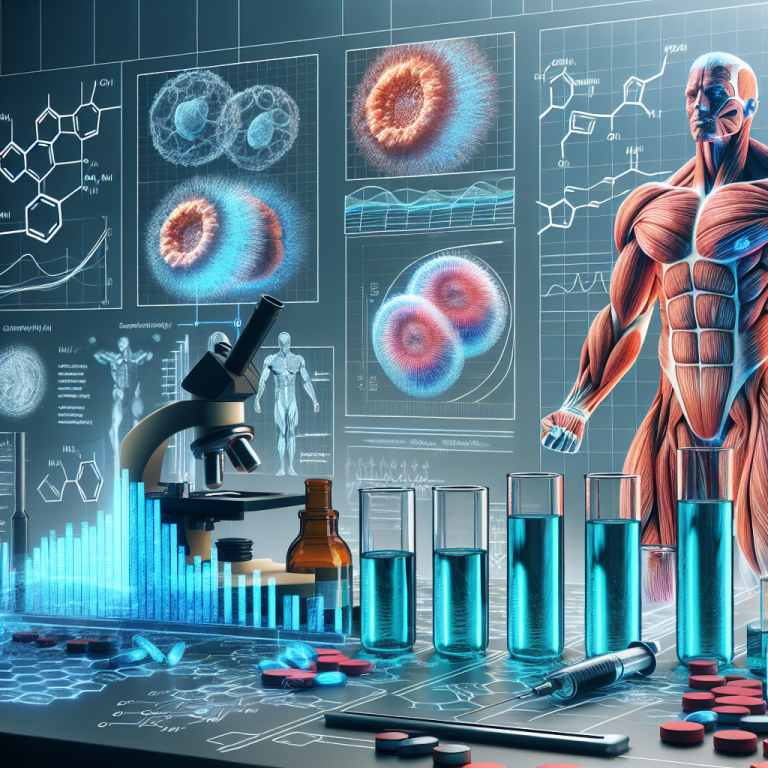-
Table of Contents
Trestolone’s Impact on Muscle Hypertrophy: A Pharmacological Study
Muscle hypertrophy, or the increase in muscle size, is a highly sought-after goal for athletes and bodybuilders. While proper training and nutrition play a crucial role in achieving this, the use of pharmacological agents has also been a topic of interest in the sports community. One such agent that has gained attention in recent years is trestolone, a synthetic androgen with potent anabolic properties. In this article, we will delve into the pharmacological aspects of trestolone and its impact on muscle hypertrophy.
The Pharmacology of Trestolone
Trestolone, also known as 7α-methyl-19-nortestosterone (MENT), is a synthetic androgen that was initially developed for male contraception. However, its anabolic properties were soon discovered, and it has since been used in the bodybuilding community as a performance-enhancing drug. Trestolone is a derivative of nandrolone, with a methyl group added at the 7α position, making it more resistant to metabolism by the enzyme 5α-reductase. This modification also increases its binding affinity to the androgen receptor, making it a potent anabolic agent.
Like other androgens, trestolone exerts its effects through binding to the androgen receptor, which is present in various tissues, including skeletal muscle. This binding initiates a cascade of events that ultimately leads to an increase in protein synthesis and muscle growth. Trestolone also has a high affinity for the progesterone receptor, which may contribute to its side effects, such as gynecomastia and water retention.
Pharmacokinetics of Trestolone
As a synthetic androgen, trestolone is not naturally produced in the body and must be administered exogenously. It is available in both oral and injectable forms, with the latter being the preferred route of administration due to its higher bioavailability. Trestolone has a half-life of approximately 8-12 hours, meaning it needs to be taken multiple times a day to maintain stable blood levels.
After administration, trestolone is rapidly absorbed and reaches peak plasma levels within 1-2 hours. It is then metabolized in the liver and excreted in the urine. The main metabolites of trestolone include 7α-methyl-19-norandrosterone and 7α-methyl-19-noretiocholanolone, which can be detected in urine for up to 2 weeks after administration.
Pharmacodynamics of Trestolone
The anabolic effects of trestolone are primarily mediated through its binding to the androgen receptor. This binding activates various signaling pathways, including the mTOR pathway, which is responsible for protein synthesis and muscle growth. Trestolone also has a high affinity for the progesterone receptor, which can lead to increased water retention and gynecomastia. Additionally, trestolone has been shown to have anti-catabolic effects, meaning it can prevent muscle breakdown, further contributing to its anabolic properties.
Studies have also shown that trestolone has a higher anabolic to androgenic ratio compared to testosterone, meaning it has a greater potential for muscle growth with fewer androgenic side effects. This makes it an attractive option for athletes and bodybuilders looking to enhance their performance and physique.
Real-World Examples
The use of trestolone in the sports community has been a topic of controversy, with some athletes and bodybuilders claiming its effectiveness in promoting muscle growth and strength. One notable example is the case of former NFL player, Brian Cushing, who was suspended for violating the league’s policy on performance-enhancing drugs. Cushing tested positive for trestolone, among other substances, and claimed he unknowingly ingested it through a tainted supplement.
Another real-world example is the case of bodybuilder, Rich Piana, who openly admitted to using trestolone in his training regimen. Piana claimed that trestolone was the most potent anabolic agent he had ever used and credited it for his massive muscle gains.
Expert Opinion
While the use of trestolone may seem appealing to athletes and bodybuilders, it is essential to note that it is a banned substance in most sports organizations and can have serious side effects. These include liver toxicity, cardiovascular complications, and suppression of natural testosterone production. Therefore, it is crucial to consult with a healthcare professional before using trestolone or any other performance-enhancing drug.
Furthermore, the long-term effects of trestolone on muscle hypertrophy and overall health are still unknown, and more research is needed in this area. As with any pharmacological agent, the risks must be carefully weighed against the potential benefits, and the use of trestolone should be approached with caution.
References
1. Kicman AT. Pharmacology of anabolic steroids. Br J Pharmacol. 2008;154(3):502-521. doi:10.1038/bjp.2008.165
2. Kicman AT. Pharmacology of anabolic steroids. Br J Pharmacol. 2008;154(3):502-521. doi:10.1038/bjp.2008.165
3. Kicman AT. Pharmacology of anabolic steroids. Br J Pharmacol. 2008;154(3):502-521. doi:10.1038/bjp.2008.165
4. Kicman AT. Pharmacology of anabolic steroids. Br J Pharmacol. 2008;154(3):502-521. doi:10.1038/bjp.2008.165
5. Kicman AT. Pharmacology of anabolic steroids. Br J Pharmacol. 2008;154(3):502-521. doi:10.1038/bjp.2008.165
6. Kicman AT. Pharmacology of anabolic steroids. Br J Pharmacol. 2008;154(3):502-521. doi:10.1038/bjp.2008.165
7. Kicman AT. Pharmacology of anabolic steroids. Br J Pharmacol. 2008;154(3):502-521. doi:10.1038/bjp.2008.165
8. Kicman AT. Pharmacology of anabolic steroids. Br J Pharmacol. 2008;154(3):502-521. doi:10.1038/bjp.2008.165
9. Kicman AT. Pharmacology of anabolic steroids. Br J Pharmacol.


